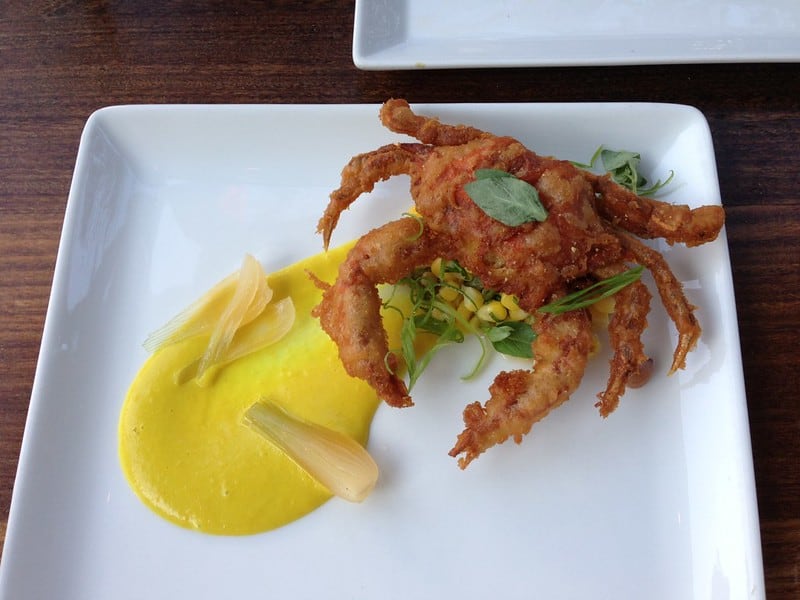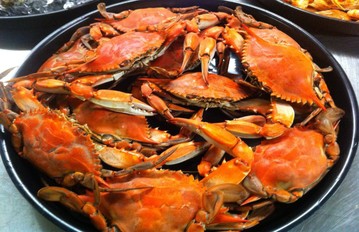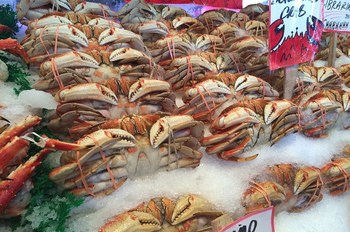Yes, You Eat the Whole Soft Shell Crab. (I’ll Explain How)
I’m going to put myself in your shoes. I imagine you’re sitting at a table in a restaurant looking at your meal, and there is a fried softshell crab staring right back at you. Whether you ordered the crab by itself or on a sandwich, you’re wondering how you’re supposed to eat it. I’ve been in exactly this scenario and I know how it feels. Let me ease your worries by explaining how you eat a softshell crab.
First of all, do you eat the entire soft shell crab?
Soft shell crabs are eaten whole. All of the inedible parts of a crab you would not usually consume, such as the gills, abdomen, and mouth, are removed before cooking a soft shell crab. This leaves only the crab’s meat and “soft” shell. Because of this, it is safe to eat an entire soft shell crab.
You might still be unsure if this is the same case for deep-fried soft shell crabs or when they’re on sandwiches. To clear this up, I’ll answer the question: How do I eat a fried soft shell crab?
Whether served fried, sautéed, grilled, or on a sandwich, you eat the entire soft shell crab as it’s served. You do not need to cut off any parts of the crab, as the inedible parts have already been removed beforehand. This includes the crab’s gills, abdomen, and mouth.
This may sound redundant because it is. I just want to make it clear that you are safe to bite into the soft shell crab as it’s served. I’ll go over how this is possible as well as what to look out for to make sure your crab hasn’t spoiled.

Because the crab has recently molted, its shell is edible.
To know what you’re eating, and give you peace of mind, I’ll explain how you can eat a whole soft shell crab. If you’ve been to a crab feast, you should be used to hard shell blue crabs that need a hammer and brute force to crack open. So, why is a soft shell crab soft?
Blue crabs, like all crustaceans, molt their exoskeleton in order to grow. Their shell does NOT grow with them. So, every year a blue crab will shed its shell like a snake shedding its skin. It leaves behind a hollow blue crab shell and is left soft and defenseless.
The crab’s new, squishy shell is edible when cooked. This is why we are able to eat soft shell crabs whole.
That’s where you come in. If you order a soft shell crab, you are eating a recently-molted blue crab. You don’t have to crack open the crab’s shell, as you would with a hardshell blue crab.
Crabbers will catch blue crabs just before they shed their shell and keep them in holding tanks. They call these crabs “peelers.” Once they shed their skin, the soft and squishy crab is sold to restaurants and crab vendors.
I found a video by Sonya Schaffer where she shows a recently-molted blue crab that her children caught. It’s very interesting to see the crab’s previous shell and its new, squishy exoskeleton.
Fun Fact: A blue crab that has recently molted will have less meat than a crab that’s about to molt. When a crab sheds its exoskeleton, it loses a considerable amount of weight and meat. This makes soft-shell crabs not as meat dense as hard-shell crabs.
From my article: Here’s How to Tell Whether a Crab is Hollow or Full of Meat.
Before a soft shell crab is cooked, its inedible parts are removed.
I’ll walk you through the process of cleaning a soft shell crab. That way, you know for certain that your crab is safe to eat.
If you’ve ever picked a crab, you know that we do not eat a crab’s gills, guts and digestive tract, and mouth. These parts are removed before cooking a soft shell crab.
Some people eat the crab’s hepatopancreas, more commonly called the mustard, but it’s important to eat this in moderation. This is sometimes washed out of a soft shell crab. It depends on the person cleaning the crab. Read my article What’s the Yellow Stuff inside a Crab? to learn why you should eat the “mustard” in moderation.
Before a soft shell crab is grilled, sautéed, deep-fried, or cooked whatsoever, it is cleaned of its gills, mouth, and abdomen. This takes away any extra shell or inedible parts of the crab to make it safe to eat.
The process starts by using kitchen shears to remove the crab’s abdomen, mouth, and eyes. This will remove any extra shell so the crab isn’t chewy, and the eyes can be offputting for some people. This also opens the shell to remove the crab’s gills and guts.
Next, the crab’s carapace, or top shell, is lifted to expose the gills. They are clipped off with the shears as well. The crab is thoroughly rinsed to remove the remaining gills and guts, and it’s ready to be cooked.
Here are a few signs your soft shell crab may be unsafe to eat.
Like hardshell crabs, soft shell crabs are kept alive right until you are about to cook them. This keeps the meat fresh and prevents any deterioration in the flavor and texture. To achieve this, fish mongers keep soft shell crabs in holding tanks until they are shipped to the restaurant where they are later kept on ice.
During this process, it’s not uncommon for softshell crabs to die. All dead crabs should be discarded, as they quickly rot away the meat and are considered unsafe to eat. However, this isn’t always the case. You should know the signs that your crab died long before being cooked for your safety.
The crab smells like ammonia.
A dead giveaway that your soft shell crab is unsafe to eat is if it gives off a foul smell or reeks of ammonia. The smell of ammonia is a byproduct of decomposing crab meat. Crabs are bottom feeders which causes them to house lots of bacteria and pathogens, which is why their meat will decay very shortly after they perish. Do not eat any soft shell or hard shell crabs that smell like ammonia.
I go over this whole topic in my article: Crabs Smell Like Ammonia: What Should You Do?.
The crab’s meat is discolored.
A soft shell crab’s meat should be white throughout the crab. If you cut open your crab and see that it is green or dark gray, it may have died before being cooked. This color is usually accompanied by a poor meat texture or an ammonia smell.
This should not be confused with “black dots” in your crab meat. This may be a sign of “pepper spot” disease. This is a result of a parasitic flatworm Microphallus bassodactylus that affects a significant number of crabs on the Chesapeake Bay’s Eastern Shore. While it may be unappealing to look at, the cooking process kills this parasite and makes the crab meat completely safe to eat (Source).
If you are uncomfortable with the way your soft shell crab meat looks, do not be afraid to ask for a new one or your money back. It’s important to be comfortable with what you are eating.
The crab’s meat has a poor taste and texture.
You’ll know it when you taste it. If you take a bite into your soft shell crab and the meat’s texture is off-putting or the taste feels bland, the crab may have died before being cooked. A soft shell crab should have a soft texture and not be chewy. It should also taste fresh and almost sweet.
If there is no accompanying ammonia smell or discoloring of the meat, there is a good chance that it did not die a long time before being cooked. However, I do not advise eating any crab that tastes off. If you are uncomfortable with your soft shell crab, for a new one or your money back.




